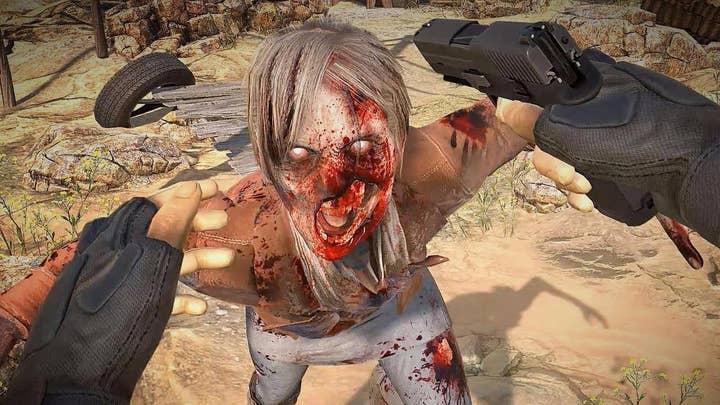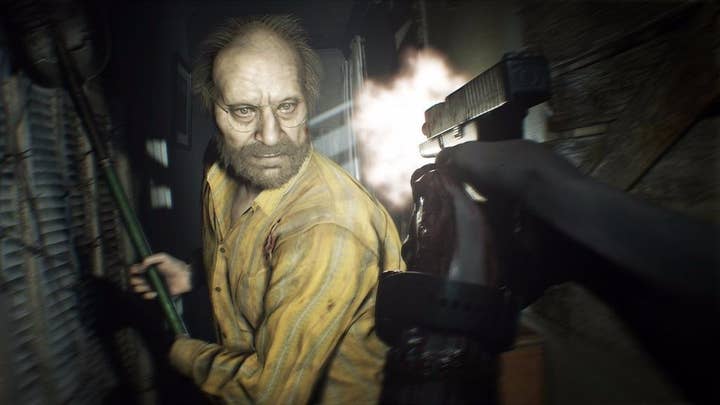"This year there will be longer and better VR games than Arizona Sunshine"
Vertigo Games on finding success in a limited market, the importance of the long tail, and what Resident Evil 7 means for VR
The VR market might take years to reach its full potential, but right now there's a pressing need for a few hits. Stories of success can provide an antidote to the downgraded analyst forecasts and doomsaying think pieces; tangible evidence that developers are making money and building communities, even if the loftier ambitions of the VR platforms are bound up in five and ten-year plans.
In a talk at Casual Connect earlier this month, Valve's Chet Faliszek singled out one game for praise in that respect: Arizona Sunshine, an action title that its creator, Vertigo Games, had recently proclaimed to be the fastest-selling PC VR game to date, reaching $1.4 million in revenue after a month on sale. Faliszek didn't question that idea; instead, he attempted to locate why Arizona Sunshine had proved so popular.
"If you describe Arizona Sunshine at a high level it sounds like a bunch of other games," he said, referring to the core experience of killing waves of zombies. "But Vertigo Games has been super successful. That's because Vertigo bought something to the game, they bought themselves to the game. It has a bunch of little touches that show who they are, and how they think about games.
"We wanted to do a full game... Something the player would expect from AAA, but AAA for VR"
"And they took the time to polish. That's really important right now. If you can afford it, you should take that extra month or two and just polish, to make sure you're adding those elements into the game and the world that players can really grasp onto."
Speaking to Richard Stitselaar, managing director of the Rotterdam-based studio, it's clear that Arizona Sunshine isn't the product of a gold rush; the frantic dash to be first to market that often plays out when new platforms emerge. Vertigo had been an early convert to VR, he says, with the company's entire team seeing enough potential in the Oculus Rift Kickstarter to consider pivoting away from the serious games that, until then, had been its main source of revenue. However, upon receiving the Oculus DK1, it was immediately clear that little about VR lent itself to a hurried approach.
"We had a traditional way of building games in mind and we applied that to VR, which didn't really work," he says, referring to Vertigo's first VR project, World of Diving. "Basically, that's the project where we learned a lot. Everything changed so quickly. DK1 was 60 frames-per-second, then it was 75 frames-per-second, then you had to go to 90. The game wasn't built for that."

Ultimately, World of Diving was a learning experience, but it did alert both Valve and Oculus to Vertigo's existence, leading to direct and productive relationships with the nascent industry's two most important companies. Indeed, Vertigo was one of 13 VR developers selected by Valve to be part of the GDC showcase that accompanied the announcement of the Vive in 2015. Stitselaar and his team had access to the most advanced VR hardware before the world even knew it existed. Suddenly, the path forward seemed obvious.
"VR was becoming bigger and bigger and bigger," he says. "We already had one game on the market with World of Diving, we already had the opportunity to work with both Valve and Oculus, so we made the decision to go ahead and make a full-blown game, which became Arizona Sunshine."
"We hit that, breaking even, in a month. If sales were lower it might have taken three months"
As Vertigo worked on possible concepts, the flow of new games and applications for VR was steadily increasing. Though the Rift and the Vive weren't yet consumer products, it seemed likely that the early market would have no small amount of "demos" and "experiences." Vertigo didn't want to become just another in card in the deck, even if that meant not having a product ready for launch day. "A lot of stuff out there was smaller," Stitselaar says, "but we wanted to do a full game. A premium experience with high-resolution graphics; something the player would expect from AAA, but AAA for VR."
This is the quality that Faliszek highlighted in his talk at Casual Connect, and it's a quality evident in the other prominent success story in VR recently: Survios' Raw Data, reported to be the first VR game to earn $1 million in revenue in a month. Both products extol similar virtues, taking a familiar gameplay concept, optimising it to make the most of the immersive qualities of VR, polishing to a radiant shine, and making very, very sure that the player has a reason to keep going beyond 30 minutes.
"If you're going to charge people the premium price, you should give them a more premium experience," Stitselaar adds. "There are a couple of titles out there doing that already. Raw Data is one. I'm guessing there will be more and more in the coming months."
In a market as young as VR, with so few headsets out there in the world, the temptation for a small studio like Vertigo is to release products quickly and see what sticks. However, the decision to spend more time and allocate more resources to a single game proved to be less risky than it seemed at first. With a team of just 12 people, and with getting the most performance from every hour and dollar spent always the highest priority, Arizona Sunshine broke even in a matter of weeks. "Right now, the amount of units we're selling, it was our most optimistic forecast," Stitselaar says. "We hit that, breaking even, in a month. If sales were lower it might have taken three months.
"For us, the game is profitable. And I think, at this point, if you're going to spend millions and millions of a dollars on a VR game, it's tricky thing to get the money back."
"We'll definitely need to spend more money on our next project. Luckily, we're in a position where we can"
Despite that initial boom, though, Stitselaar believes that the real value in the VR market will be in the long tail. Arizona Sunshine had a great first month, but the fact that it was created for high-end, motion-control VR means that it will continue to be relevant as new users pour into the market in the months and years ahead. "Arizona has been out there for so long - the first announcement was almost two years ago - and still people are talking about it," he says. "With normal games there is momentum, but it's fairly short. With VR the market is still growing, so it's a different business model. That could be very profitable for us as a studio."
As VR hardware improves, then, Vertigo will keep on improving the way Arizona Sunshine looks and feels. Indeed, it has just released a free update for the game that uses locomotion for traversal rather than teleportation. The latter is "the only way 100% of people will not get nausea," Stitselaar says, and so it remains the best approach for first-person games. However, locomotion is a better match for VR's immersive qualities, so even though not a single member of the Vertigo team could finish Arizona Sunshine in that way - "we had to take shifts with the testing to make sure people didn't get sick" - it is there as an option for those with enough fortitude. The point is to stay relevant, for as many people as possible.
Vertigo will now do the same for World of Diving, returning to its early "experiment" with all of the lessons and best practices gleaned from Arizona Sunshine. It will also push ahead with Skyworld, a colourful, room-scale turn-based strategy title that was initially announced alongside the Vive.

Whether Vertigo can hold its position as one of the leading VR developers remains to be seen, but the recent success of Resident Evil 7 shows how quickly competition is escalating. The latest entry in Capcom's long-running franchise is entirely playable in VR; indeed, its first-person viewpoint hints that it might have been created with VR firmly in mind. In any case, more than 140,000 players have tried its VR mode, despite the game only being available for PlayStation's headset.
When the big publishers talk about a "wait and see" approach to VR, this might be what they're waiting to see. "Somebody needs to be the first one," Stitselaar says. "There are a lot of indies out there, some of them are successful, and of course publishers are looking at that. But this is the first big publisher to have the numbers, to have a hit with VR.
"Arizona Sunshine fits for the current time: the scale of the game, the length, the pricing; it really works for right now. But our next game, the market at that point will be bigger, there will be more AAA publishers when we release that game. We'll definitely need to spend more money on our next project. Luckily, we're in a position where we can. The next one will have more than Arizona."
"Last year was the launch of VR. There were some really cool games, but it was the start. This year there will be longer and better VR games than Arizona Sunshine. The market will grow - 2017 will be a very interesting year for VR."
GamesIndustry.biz now has a newsletter dedicated to the emerging markets for VR and AR. You can sign up here.








